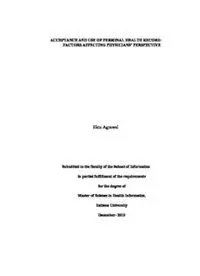
Personal health record is an evolving concept in health care PDF
Preview Personal health record is an evolving concept in health care
ACCEPTANCE AND USE OF PERSONAL HEALTH RECORD: FACTORS AFFECTING PHYSICIANS’ PERSPECTIVE Ekta Agrawal Submitted to the faculty of the School of Informatics in partial fulfillment of the requirements for the degree of Master of Science in Health Informatics, Indiana University December- 2010 Accepted by the Faculty of Indiana University, in partial fulfillment of the requirements for the degree of Master of Science in (Health Informatics) Master’s Thesis Committee ______________________________________ Dr. Josette Jones, Ph.D., Committee Chair _______________________________________ Dr. Michael Weiner, M.D., M.P.H. ________________________________________ Jennifer Simmermaker, M.A., R.N. ii Dedicated to My respected parents Mr. Bhagwatiprasad Kedia and Mrs. Vimala Kedia My beloved husband Sanjay Agrawal & My wonderful and loving children Nikhil and Himani iii TABLE OF CONTENTS LIST OF TABLES ............................................................................................................................................. vi LIST OF FIGURES .......................................................................................................................................... vii ACKNOWLEDGEMENT ................................................................................................................................ viii ABSTRACT ..................................................................................................................................................... ix 1. Introduction .............................................................................................................................................. 1 2. Problem Statement ................................................................................................................................... 3 2.1 Purpose of Study: ....................................................................................................................... 5 2.2 Scope and Limitations ................................................................................................................ 5 3. Background ............................................................................................................................................... 5 3.1 Current Understanding of PHR .................................................................................................. 5 3.2 Definitions of PHR ...................................................................................................................... 7 3.3 PHR Functionalities ................................................................................................................ 10 3.4 Adoption of PHR ....................................................................................................................... 11 3.5 Current Efforts towards overcoming the barriers ................................................................... 13 3.6. Knowledge Gap ....................................................................................................................... 13 4. Theoretical Framework ........................................................................................................................... 14 5. Methods ................................................................................................................................................. 22 5.1 Data Collection: ........................................................................................................................ 23 5.2 Data analysis: ........................................................................................................................... 26 6. Results ..................................................................................................................................................... 31 7. Discussion................................................................................................................................................ 39 8. Limitations............................................................................................................................................... 46 9. Future research recommendations ........................................................................................................ 47 10. Conclusion ............................................................................................................................................. 47 11. References ............................................................................................................................................ 48 12. Appendices ............................................................................................................................................ 54 Appendix A: List of the articles selected for the literature review and data extraction ............... 54 iv Appendix B: Phase 1- Data extraction Instruction ......................................................................... 57 Appendix C: Master list of the Items/Units of Analysis extracted from the literature .................. 59 Appendix D: Modified definition of UTAUT core constructs ......................................................... 70 Appendix E: Phase two-Categorization of items/units of analysis into UTAUT Core constructs .. 71 Appendix F: Final phase-Sub categorization of the items into similar groups .............................. 94 Appendix G: Sub categorization and consensus based naming to each subcategory ................. 112 v LIST OF TABLES Table 1: Example of duplicate data units .................................................................................................... 32 Table 2: Identified Units of Analysis .................................................................................33 Table 3: Categorization of data units (units of analysis) into core UTAUT constructs ....35 Table 4: Final categorization and identified domains ................................................................... 38 vi LIST OF FIGURES Figure 1: Unified Theory of Acceptance and Use of Technology Model (Venkatesh et al. 2003)……………………………………………………….22 vii ACKNOWLEDGEMENT I would like to extend my gratitude to my thesis advisor Dr. Josette Jones for her constant support, guidance and encouragement towards the completion of my thesis and entire graduate study. I would also like to thank Dr. Michael Weiner and Jennifer Simmermaker for their valuable time for being on my thesis committee and providing valuable suggestions. I wish to acknowledge the help and support I have received from my fellow students Jaci Drexler, Tamara McQueen and Sudha Iyer. I would also like to thank my colleague Kaye Gilmore for reading my thesis and providing the valuable suggestions. Finally, my special thanks to my husband Sanjay Agrawal and my children Nikhil and Himani for their great support and encouragement throughout this process. viii ABSTRACT Ekta Agrawal ACCEPTANCE AND USE OF PERSONAL HEALTH RECORD: FACTORS AFFECTING PHYSICIANS‘ PERSPECTIVE Acceptance of PHR by physicians is fundamental as they play important role towards the promotion of PHR adoption by providing the access to the data to be maintained in PHR and also, using the information within the PHR for decision making. Therefore it is important to measure physicians‘ perspective on usefulness of PHR, and also the value and trust they have in PHR usage. Review of previous researches identifies the lack of availability of a valid survey instrument that can be used to measure physicians‘ perception on all different aspects of PHR use and acceptance. Using the integrated literature review methodology and Unified Theory of Acceptance and Use of Technology (UTAUT) as a guiding framework, this study was aimed to identify the factors that can be used in the development of comprehensive evaluation instrument to understand physicians‘ acceptance of PHR. Total 15 articles were selected for literature review and using the content analysis method, 189 undifferentiated data units were extracted from those articles. These data units were then categorized into the four core constructs of UTAUT. ―Other‖ categorization system was also created for the data units that could not be classified into one of the UTAUT core constructs. ix Among four core UTAUT constructs, Performance Expectancy is found to be the most influential factor in physicians‘ acceptance of PHR, followed by ―Other‖ factors, Facilitating Condition and Social Influence. Effort expectancy was found to be the least influential. The identified specific factors within each domain can be used to develop a valid survey instrument to measure physicians‘ perception on PHR. x
